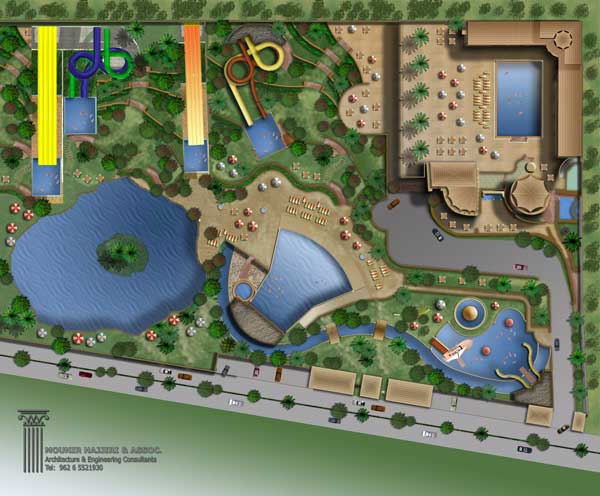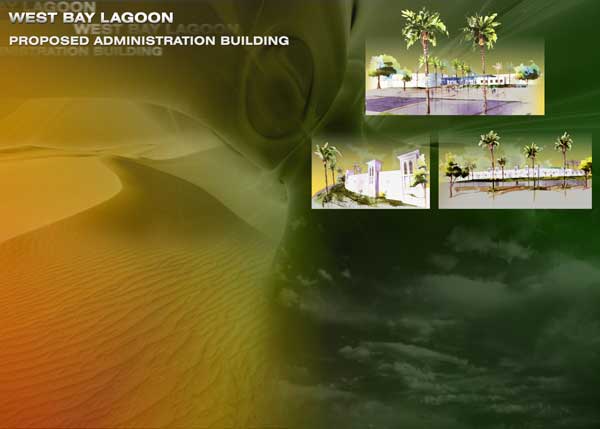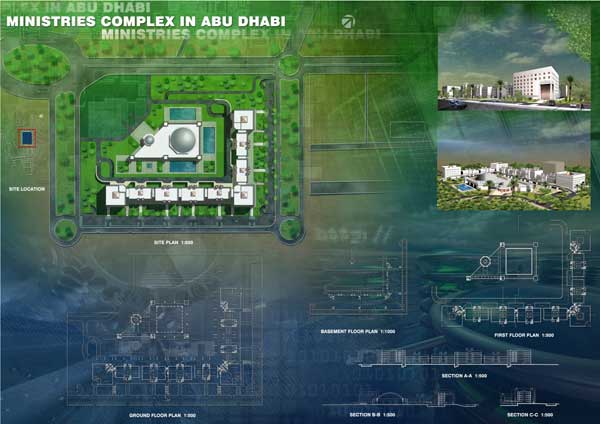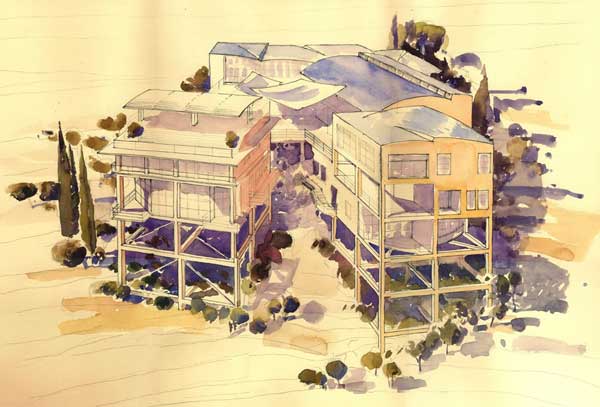Click here to go back to News 2002
Completed Projects
Preparations are underway for the opening of the Royal Car Museum at al-Hussein National Park in Amman. The Municipality of Greater Amman project houses the late King Hussein's car collection. Jafar Tukan and Partners designed the 2 million JD (2.8 million $US) project that occupies an area of 5,200 square meters. The museum includes several showrooms featuring more than 60 of the Late King Hussein’s automobiles, in addition to motorcycle miniatures. It also houses a maintenance department, a warehouse for spare parts, as well as a cafeteria and souvenir shop. The museum will open its doors to the public as part of the Independence Day celebrations on May 25th, 2002. (Source: The Jordan Times, May 14, 2002)
Construction work was completed on the Suhaib Tunnel project at the intersection of Zahran and al-Madina al-Munawwara streets. The Municipality of Greater Amman carried out the construction of the 400-meter-long, one-way, two-lane tunnel, which cost 1.3 million JD (1.8 million $US). Work on the junction also included developing designs for landscaping, lighting, pavement works, rainwater drainage systems, and ceramics decorating the interior of the tunnel. (Source: The Jordan Times, May 28, 2002)
The Municipality of Greater Amman inaugurated five public parks in Amman. The projects, which cost a total of 450,000 JD (635,000 $US), have included the planting of trees and flowering plants, the development of open spaces and children’s playgrounds, and the installation of benches and umbrellas. The parks are located in the areas of Tariq, ‘Abdali, Badir, Ras al-‘Ain, and Abu Nuseir, and are part of the municipality’s efforts at increasing green open spaces in the city. (Source: The Jordan Times, May 28, 2002)
The Municipality of Greater Amman inaugurated Bayt al-Fann (House of Art) as part of the Amman Arab Cultural Capital 2002 celebrations. The House of Art occupies a renovated building dating to the 1920’s and located in downtown Amman. The project was carried out in cooperation with a number of organizations including the Jordan River Foundation, the National Music Conservatory, the Noor al-Hussein Foundation, the Department of Antiquities, the Jordan Radio and Television Corporation, the Ministry of Culture, and the Plastic Artists Association. The project consists of two floors that house several wings showcasing various aspects of Jordanian life, art, music, and drama. (Source: al-Ra'i, May 20, 2002)
Initiation of Projects
Demolition works are underway in the ‘Abdali district of Amman as part of the ‘Abdali Regeneration Project. The 1.2 billion JD (1.7 billion $US) project is financed and executed by the state-run National Resources Investment and Development Corporation (NARIDEC). The project is located on a 33.4-hectare state-owned land that contained the headquarters of the Jordanian Armed Forces and other security agencies. These will be relocated to other areas in order to transform the site into a multi-purpose business district.
The project is expected to take six to nine years before completion, and will include a university, as well as commercial and residential areas. The project is expected to attract considerable investment because of its strategic location between the downtown area and Shmeisani, the capital’s financial district.
The area will be designed to provide a pedestrian-friendly environment that seeks to create a vibrant urban setting and encourage social interaction. Consequently, parks, pathways, and public areas will comprise 30% of the site. Motor vehicles will not be allowed into the complex, except into underground parking facilities.
Fifty-two existing buildings already have been demolished. Another demolition stage is planned to begin in June 2002, and construction work is scheduled to begin by the end of this year, after the relevant technical and economic studies are carried out. (Source: The Jordan Times, May 17, 2002)
Plans to develop an urban complex to be located on the site of the old military camp of the city of Zarqa are underway, with the project moving into its second phase, which includes attracting investment and developing infrastructure works. The state-run National Resources Investment and Development Corporation (NARIDEC) is in charge of administering the project, which is expected to be implemented over a period of about fifteen years. SIGMA Consulting Engineers, in association with the Jordanian Consulting Engineers and the Egyptian firm Sabbur, developed the master plan for the 25 square-kilometer site that will include residential neighborhoods and shopping centers. The pilot phase of the project will provide housing for 23,000 inhabitants, but is intended to eventually house about 500,000 people. The project is designed to relieve population densities and infrastructure pressures in Zarqa, which is among the most densely populated urban centers in Jordan.
Basic infrastructure works for the project are estimated to cost 14 million JD (20 million $US), and the total cost of the development is estimated at 500 million JD (700 million $US). (Source: The Jordan Times, May 19, 2002)
Urban Complex in the Old Military Camp of Zarqa
The Ministry of Public Works and Housing initiated construction on the final phase of the Jordan Ring Road that will link with the Amman-Irbid highway through the ‘Ayn al-Basha district. The four-lane road aims at connecting the northern parts of the country with the capital and at reducing traffic congestion at Amman’s northern exit points. This final phase of the project is expected to cost 10 million JD (14 million $US). (Source: al-Ra'i, May 28, 2002)
Construction has started on a new housing project located to the north of the town of Safut in the ‘Ayn al-Basha district. The project, which occupies a three-hectare site, is being carried out by the Housing and Urban Development Corporation. (Source: al-Ra'i, May 16, 2002
Construction work began on the Amman Water Park, which is located on Airport Road outside Amman. Mounir Hajjiri and Partners designed the 35,000 square-meter water park for entrepreneur Sami ‘Assi. The 8.5 million JD (12 million $US) project will be the first water park in Jordan.
The Amman Water Park
The Amman Water Park
Completed Designs
Al-Marsam Architects and Engineers, in association with GDAR Group as sub-consultants, completed designs for the interior and refurbishment works for the auditorium of the Jordan National Medical Council in Amman. The 210,000 JD (300,000 $US) project is part of the Primary Health Care Initiative Program that USAID (United States Agency for International Development) is funding to improve health care resources in Jordan.
The 400 square-meter project includes the interior design and fitting of an existing auditorium shell and foyer. The auditorium, which has a seating capacity of 300 people, is intended to serve as a venue for conferences, seminars, and workshops for the medical profession. The project was awarded to al-Marsam Architects and Engineers through a staged tendering process organized by the Cambridge, Massachusetts-based research and consulting firm Abt Associates.
The Auditorium of the Jordan National Medical Council
Darb (Design Associates and Research Bureau) completed designs for the Pinewood Private Resort. The 10,000 square-meter resort occupies a 30,000 square-meter site located at the outskirts of Amman. Preparations currently are being made to float the construction tender for the project.
Competitions
Jafar Tukan and Partners, in a joint venture with the American Engineering firm Stanley Consultants, participated in a competition for the design of a 2,300 square-meter administration building for the West Bay Lagoon in Qatar. The West Bay Lagoon district is located to the north of the city of Doha, and is evolving into an exclusive development of residential properties and hotels. It consists of a man-made lagoon with two islands connected to the mainland through five bridges.
Jafar Tukan and Partners, in a joint venture with the Abu Dhabi-based Khatib and Alami Consolidated Engineering Company, participated in a competition for the design of a complex of ministry buildings in Abu Dhabi for the Federal Government of the United Arab Emirates. The 10,000 square-meter project will include ministry buildings and a convention center. The new buildings will replace the old ministry buildings that currently occupy the site.
Submission by Jafar Tukan and Partners for an Administration Building in West Bay Lagoon competition
Submission by Jafar Tukan and Partners for the Complex of Ministries Buildings competition
News from Academia
Rami Daher, assistant professor at the Department of Architecture at the Jordan University of Science and Technology (JUST) in Irbid, received an International Collaborative Research Grant (ICRG) from the Program on the Middle East and North Africa of the Social Science Research Council (SSRC). The research project is entitled Domains of Heritage: Shifting Boundaries and the Emergence of a ‘Transformed Public Consciousness’: The Politics of Place and Identity Construction, Contested Pasts, and Investment Rights in Bilad al-Sham. A team of researchers from Jordan, Syria, the United Kingdom, and the United States has been formed to work on this collaborative research project.
The Project will last from June 2002 until December 2003, and will include organizing workshops and an exhibition, as well as publishing a monograph and research articles.
The board of trustees of the Applied Sciences University in Amman has approved restructuring the university’s Department of Architecture into a Faculty of Architecture and Fine Arts beginning in the 2002 - 2003 academic year. As is the case with other departments of architecture in Jordan, this one currently is a part of the university’s Faculty of Engineering.
Lectures
Rami Daher, assistant professor at the Department of Architecture at the Jordan University of Science and Technology in Irbid, delivered a lecture at the Department of Architecture and Design at the American University of Beirut entitled A Critical/Multi-Discursive Approach to Reading Historic Public Place: Heritage places, Sites for Practice of Power and Socioeconomic Conflict.
Exhibitions
The Jordanian Architects Society held a book exhibition featuring issues of Albenaa, the Arabic-language monthly architecture magazine published from Riyadh, Saudi Arabia, and the architectural publications of the Jordan Engineers Association and the Jordanian Architects Society. (Source: al-Ra'i, May 13, 2002)
Seminars
Maher Khoury, managing partner at Darb (Design Associates and Research Bureau) presented a paper entitled Using High Strength Concrete Reinforcing Steel in Jordan at a seminar organized by the Jordan Concrete Association.
Hikmat Hammad, assistant professor at the Department of Architecture at the Jordan University of Science and Technology, presented a paper entitled A Future Vision of Residential and Environmental Architecture at a seminar organized by the Al-Baath University in Homs, Syria.
Other News
The Salt Development Corporation is preparing a draft law that extends legal protection for Jordan’s cultural and architectural heritage beyond 1700 AD, which is the year at which the current law stops. The draft law will be presented to the Jordanian Cabinet for approval. (Source: al-Ra'i, May 1, 2002
The Municipality of Greater Amman invited tenders for the construction of the cable-stayed bridge component of the Abdoun Valley Bridge Project. The project will connect the Fourth Circle from the north with the Abdoun Roundabout from the south, and also will function as a segment of an inner ring road planned for Amman. The project consists of two levels of underpasses that begin at the Fourth Circle, one of which will lead to the Abdoun Valley Bridge, and from there to a tunnel that leads to the Abdoun Roundabout. The bridge will be 425 meters long, and will rise 40 meters above the lowest point of the valley. The project is expected to cost over 10 million JD (14 million $US). (Source: The Jordan Times, May 13, 2002)
The Jordanian Government has allocated 34,000 JD (49,000 $US) for archeological digs and conservation efforts in the Madaba Governorate. The funds will be used to carry out activities that include fencing archeological sites, maintaining mosaic surfaces, conserving archeological findings, and carrying out new excavation work at the site of Umm al-Rasas, which contains remains from the Roman, Byzantine, and early-Islamic periods. (Source: al-Ra'i, May 1, 2002)
The Jordanian Ministry of Health is carrying out a comprehensive 3-phase plan to upgrade and modernize al-Bashir Hospital in Amman, which is Jordan’s main public hospital. The 3-phase project, which includes a built up area of 43,800 square meters, is expected to cost 40 million JD (57 million $US) and is scheduled for completion in the year 2007. Completion of the first phase of the project is scheduled for 2003. Dar al-Omran carried out the designs for the first phase of the renovation project that include designing a new master plan for the hospital complex and designing new medical facilities that include maternity and pediatric wings with a capacity of 350 beds. (Source: al-Ra'i, May 28, 2002)
The Building Research Center at the Royal Scientific Society completed a project that addresses the assessment of earthquake-damaged buildings. A workshop will be organized to demonstrate the results of the project, and a guide for damage assessment will be published. The project, which was funded by the Higher Council for Science and Technology (HCST), was carried out in association with the Civil Defense Directorate and the Housing and Urban Development Corporation. (Source: al-Ra'i, May 27, 2002)
The Royal Society for the Conservation of Nature (RSCN) has completed studies related to establishing tourist facilities in a number of nature reserves and other sites in Jordan. The project, which is expected to cost 2.1 million JD (3 million $US), is being funded by USAID (United States Agency for International Development). It includes the construction of a Nature Center in the Jabal Amman district of Amman and wilderness lodges in Azraq and Wadi Finan, which have been designed by Ammar Khammash Architects. (Source: al-Ra'i, May 27, 2002)
The Nature Center
The Nature Center
The Center for the Study of the Built Environment (CBSE) officially launched the Water Conserving Landscapes section of the center’s web site. This section of the CSBE web site aims at providing detailed information concerning the principles and practices of creating water-conserving landscapes. The searchable web section includes illustrated plant lists, articles, a bibliography containing web-based and printed references, and a directory of suppliers of products and services relating to landscaping.
the logo for CSBE’s Water Conserving Landscapes web section









